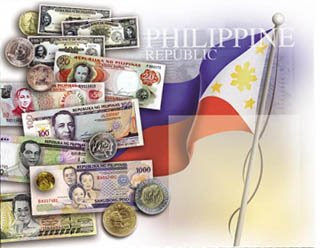History of Philippine Money
Philippine money–multi-colored threads woven into the fabric of our social, political and economic life. From its early bead-like form to the paper notes and coins that we know today, our money has been a constant reminder of our journey through centuries as a people relating with one another and with other peoples of the world.
Pre-Hispanic Era
Trade among the early Filipinos and with traders from the neighboring islands was conducted through barter. The inconvenience of barter later led to the use of some objects as medium of exchange. Gold, which was plentiful in many parts of the islands, invariably found its way into these objects that included the piloncitos, small bead-likeb gold bits considered by the local numismatists as the earliest coin of the ancient Filipinos, and gold barter rings.
Spanish Era (1521-1897)
Three hundred years of Spanish rule left many indelible imprints on Philippine numismatics. At the end of the Spanish regime, Philippine money was a multiplicity of currencies that included Mexican pesos, Alfonsino pesos and copper coins of other currencies.
The cobs or macuquinas of colonial mints were the earliest coins brought in by the galleons from Mexico and other Spanish colonies. The silver dos mundos or pillar dollar is considered one of the world’s most beautiful coins. The barilla, a crude bronze or copper coin worth about one centavo, was the first coin struck in the country.
Coins from other Spanish colonies also reached the Philippines and were counterstamped. Gold coins with the portrait of Queen Isabela were minted in Manila. Silver pesos with the profile of young Alfonso XIII were the last coins minted in Spain. The pesos fuertes, issued by the country’s first bank, the El Banco Espanol Filipino de Isabel II, were the first paper money circulated in the country.
Revolutionary Period (1898-1899)
 Asserting its independence, the Philippine Republic of 1898 under General Emilio Aguinaldo issued its own coins and paper currency backed by the country’s natural resources.
Asserting its independence, the Philippine Republic of 1898 under General Emilio Aguinaldo issued its own coins and paper currency backed by the country’s natural resources.
One peso and five peso notes printed as Republika Filipina Papel Moneda de Un Peso and Cinco Pesos were freely circulated. 2 centimos de peso copper were also issued in 1899.
The American Period (1900-1941)

The Americans instituted a monetary system for the Philippine based on gold and pegged the Philippine peso to the American dollar at the ratio of 2:1. The US Congress approved the Coinage Act for the Philippines in 1903.
The coins issued under the system bore the designs of Filipino engraver and artist, Melecio Figueroa. Coins in denomination of one-half centavo to one peso were minted. The renaming of El Banco Espanol Filipino to Bank of the Philippine Islands in 1912 paved the way for the use of English from Spanish in all notes and coins issued up to 1933. Beginning May 1918, treasury certificates replaced the silver certificates series, and a one-peso note was added.
The Japanese Occupation (1942-1945)

The outbreak of World War II caused serious disturbances in the Philippine monetary system. Two kinds of notes circulated in the country during this period. The Japanese Occupation Forces issued war notes in big denominations. Provinces and municipalities, on the other hand, issued their own guerrilla notes or resistance currencies, most of which were sanctioned by the Philippine government in-exile, and partially redeemed after the war.
The Philippine Republic

A nation in command of its destiny is the message reflected in the evolution of Philippine money under the Philippine Republic. Having gained independence from the United States following the end of World War II, the country used as currency old treasury certificates overprinted with the word “Victory”.
With the establishment of the Central Bank of the Philippines in 1949, the first currencies issued were the English series notes printed by the Thomas de la Rue & Co., Ltd. in England and the coins minted at the US Bureau of Mint. The Filipinazation of the Republic coins and paper money began in the late 60’s and is carried through to the present. In the 70’s, the Ang Bagong Lipunan (ABL) series notes were circulated, which were printed at the Security Printing Plant starting 1978. A new wave of change swept through the Philippine coinage system with the flora and fauna coins initially issued in 1983. These series featured national heroes and species of flora and fauna. The new design series of banknotes issued in 1985 replaced the ABL series. Ten years later, a new set of coins and notes were issued carrying the logo of the Bangko Sentral ng Pilipinas.
*The above information is quoted from the
Bangko Sentral ng Pilipinas website










